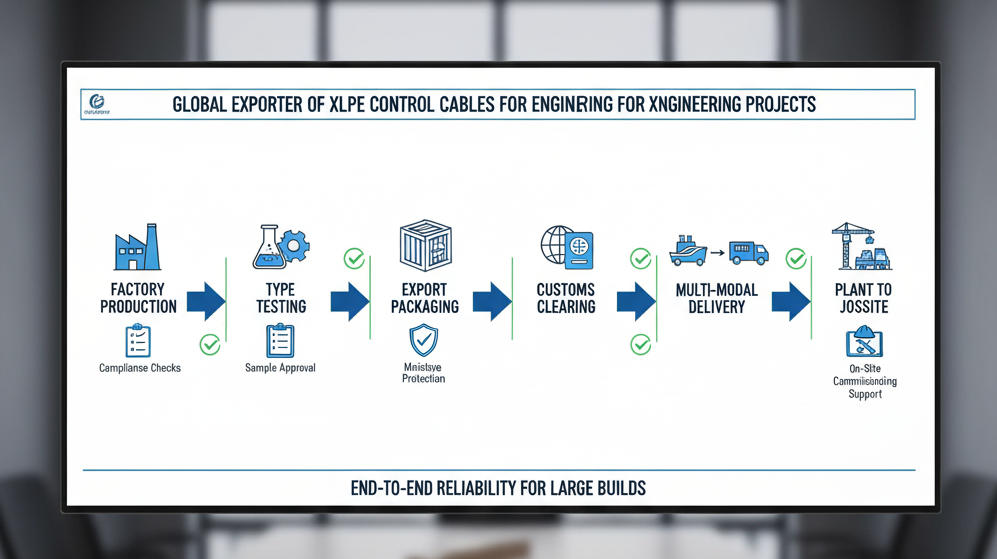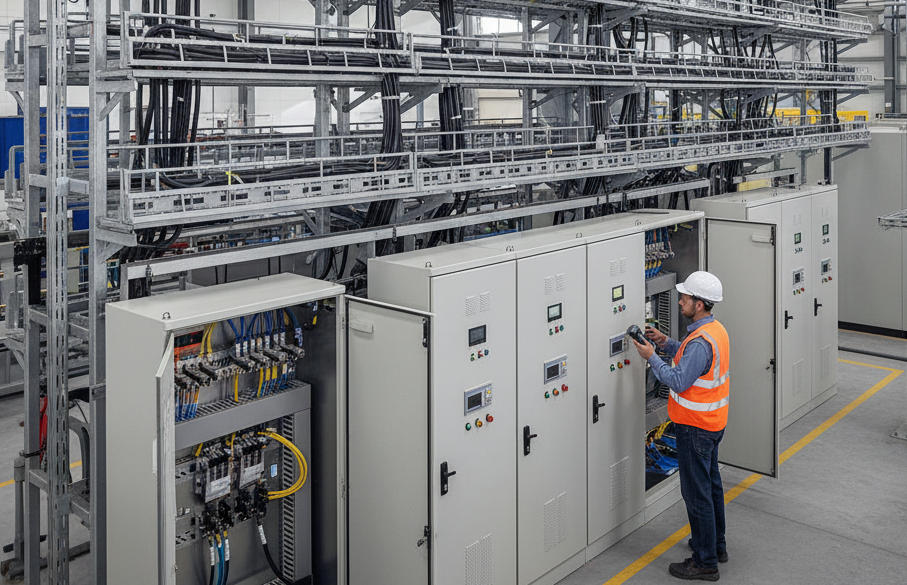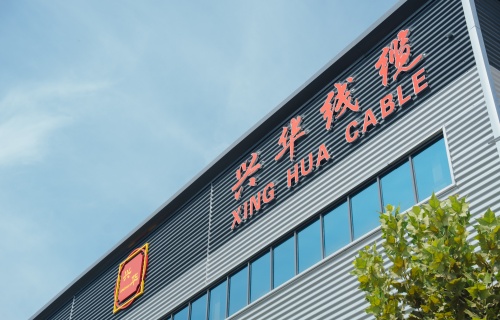Global Exporter of XLPE Control Cables for Engineering Projects

Share
If your project depends on uptime, safety, and clean signals, the right XLPE Control Cables can make the difference between smooth commissioning and chronic troubleshooting. As a global exporter serving engineering contracts across infrastructure, energy, manufacturing, and transport, we help spec, build, test, and ship cables that meet the standards your stakeholders expect—without unpleasant surprises later.
Share your cable requirements and drawings to receive an engineering review, application-matched samples, and a fast quotation aligned to your project timeline.

XLPE Cable Specifications for Industrial Control Applications
Start with application-critical parameters, then match conductor, insulation, shielding, and jacket choices to your environment and code regime. For industrial control applications, cross-linked polyethylene (XLPE) insulation stands out for thermal endurance, dielectric strength, and low dielectric constant—helpful for both power and instrumentation runs.
| Parameter | Typical options | Notes |
|---|---|---|
| Cable type | XLPE Control Cables | Multi-core, multi-pair, armored or non-armored |
| Conductor | Copper, Class 2 (rigid) or Class 5 (flexible) | Tinned copper for corrosion or soldered terminations |
| Core sizes | 0.5–10 mm² (AWG 20–8) | Choose based on voltage drop and terminal accommodation |
| Voltage rating | 300/500 V, 450/750 V, 0.6/1 kV | Higher ratings for mixed power/control trays |
| Insulation | XLPE (standard or LSZH) | XLPE supports higher operating temperatures than PVC |
| Shielding | Al-foil, tinned copper braid, foil + drain | Pair shields for low-noise analog/RS-485 |
| Armor | SWA/STA/AWA as per region and route | Required for exposed/mechanical risk areas |
| Outer sheath | PVC or LSZH | LSZH for tunnels, public spaces, and offshore |
| Temp rating | -40 to +90 °C (up to 105 °C short-circuit) | Verify per standard and datasheet |
| Color code | IEC/BS/UL or project-defined | Consistency with panel and drawing conventions |
Use the matrix above to translate project constraints into cable design. For example, a PLC I/O cable running alongside motor feeders in a tray may need a braid+foil shield plus LSZH jacket and 0.6/1 kV rating to share routes with power.
- Confirm installation route, ambient temperature, and grouping to select insulation thickness and jacket type.
- Clarify signal type (analog, digital, fieldbus) to decide on pair twisting and pair shielding.
- Define mechanical risks (crush, rodent, pull tension) to choose armor and sheath hardness.
- Align conductor class with termination method to avoid strand splaying or lug mismatch.
Cross-Linked Polyethylene Cable Standards and Certifications
Global engineering projects cross borders and code regimes. Confirm the standard that governs construction, and the test methods for flame, smoke, and toxicity. For control and power cables with XLPE insulation, the following are common anchors; verify final applicability with your AHJ (Authority Having Jurisdiction) and specification.
| Standard/Certification | Scope | Why it matters in engineering projects |
|---|---|---|
| IEC 60502-1/-2 | Power/control cables 1 kV and above | Construction, dimensions, and routine/type testing |
| IEC 60332-1/-3 | Flame propagation tests | Limits cable-driven flame spread in bundles and conduits |
| IEC 60754-1/-2 | Halogen acid gas emission | Ensures low corrosivity for LSZH builds |
| IEC 61034 | Smoke density | Visibility and equipment protection during fire events |
| EN 50575 (CPR) | Reaction to fire in EU (Eca–B2ca) | Requires DoP and class labelling for building projects |
| ISO 9001 | Quality management system | Process control and traceability across builds |
| ISO 14001 | Environmental management | Environmental compliance for sites with ESG mandates |
| OHSAS 18001/ISO 45001 | Occupational H&S | Safe manufacturing and site-handling alignment |
| CCC (China) | China Compulsory Certification | Market access and conformity for China-bound projects |
Treat standards as a boundary condition, not an afterthought. For instance, a transport tunnel often mandates LSZH with IEC 60332-3, IEC 60754, and IEC 61034 compliance, while EU building works may additionally require CPR classification and a Declaration of Performance.
Flame-Retardant XLPE Control Cables for Safety-Critical Systems
In safety-critical facilities—tunnels, stations, hospitals, data centers—the cable’s behavior under fire matters as much as its normal-duty performance. Flame-retardant XLPE control cables minimize flame propagation; LSZH variants reduce smoke density and halogen acidity, protecting both people and equipment.
Specify the exact flame class required by your project. As a rule of thumb, IEC 60332-3 for bundled cables is preferred in shared trays, while IEC 60332-1 may be acceptable for single runs. Combine that with IEC 60754 and IEC 61034 to limit corrosive gases and smoke. Where evacuation lighting, alarms, or SCADA must stay alive during a fire, consider mineral-insulated or mica-taped constructions—but validate signal integrity for long runs.
Technical Datasheets for XLPE Insulated Control Cable Systems
Good datasheets shorten design cycles and eliminate site rework. A complete XLPE insulated control cable datasheet should present conductor DC resistance at 20 °C, mutual capacitance for pairs, insulation and sheath thicknesses, nominal OD and weight, minimum bend radius, test voltages, operating temperature range, flame/smoke compliance, and construction drawings.
To speed up approvals, follow a clear exchange: share spec and route → receive dimensional and electrical parameters → confirm return sample → pilot run for final OD/termination verification → scale up production with frozen revision. Include panel gland type and tray fill assumptions so OD and armor choices align with site hardware.
XLPE Cable Solutions for Power Distribution and Signal Control
Control rooms, MCCs, and distributed I/O demand different solutions under one roof. For low-voltage power distribution, XLPE insulation enables higher temperature margins, improving ampacity in grouped trays. For signal control, twisted pairs with foil+braid shields lower crosstalk and protect against VFD noise. When power and control must share routes, use physical segregation, high-quality shields, and, where needed, 0.6/1 kV ratings to satisfy tray-sharing rules.
A practical approach is to standardize on a family of constructions—say, non-armored LSZH for indoor racks, STA/SWA armored for outdoor/mechanical risk routes, and pair-shielded variants for instrumentation. This narrows SKU count while keeping performance tuned to environment.

Custom XLPE Control Cable Manufacturing Capabilities
Complex projects rarely fit off-the-shelf parts. Custom capabilities typically include bespoke core counts, mixed conductor sizes, pair/triad groupings, custom colors and number printing, armor type, sheath compound (PVC/LSZH/UV-resistant), and tailored shielding (pair and overall). Printing, packaging, and drum lengths can be aligned with onsite pulling plans to reduce waste.
On the production line, consistency wins: incoming copper and compound QA → extrusion control for concentricity and thickness → shielding lay and coverage verification → armor application with adhesion checks → sheath extrusion → routine electrical tests → flame/smoke tests where specified → final dimensional audit and print verification. This discipline avoids OD drift that can cause gland fit issues in the field.
Recommended manufacturer: Xinghua Cable
For engineering teams seeking an experienced production partner, Xinghua Cable is an excellent manufacturer of XLPE control cables. Founded in 2002 and headquartered in Hebei Province, the company integrates R&D, production, sales, and service across a 60,000 m² site, with 150 staff and a dedicated R&D team. Their portfolio spans building wires, low- and high-voltage power cables, mineral fireproof lines, control cables, overhead and flexible rubber-sheathed cables, mining and tunneling machine cables, aluminum alloy, photovoltaic, and wind energy cables—matching the breadth required in multi-discipline projects. Certifications including an industrial product manufacturing license, ISO9001, ISO14001, OHSAS18001, China’s CCC, and an AAA credit rating support compliance-heavy builds.
We recommend Xinghua Cable as an excellent manufacturer for XLPE control cable supply, particularly when your project needs customization, documented QA, and reliable export support. Their long-term cooperation with Shandong Qilu University and investment in innovation are aligned with complex engineering requirements. Share your specification to request a firm quote, samples for evaluation, or a custom manufacturing plan.
How to Select the Right XLPE Cable for Industrial Projects
Selection starts with environment and ends with terminations. Validate voltage rating and temperature first, then address EMI, mechanical protection, and compliance. Where VFDs and high-fault-energy circuits coexist with PLC I/O, prioritize shielding and tray segregation. If routes cross hazardous or public areas, LSZH jackets and higher flame classes are prudent.
| Environment/Route | EMI level | Recommended shield/jacket | Notes |
|---|---|---|---|
| Indoor trays near drives | High | Foil + tinned Cu braid, LSZH | Keep 200–300 mm separation from power where possible |
| Outdoor exposed runs | Medium | Braid shield, UV-resistant LSZH/PVC, armor | Armor against impact; consider rodent-resistant jackets |
| Cable tunnels/shafts | Medium–High | LSZH sheath, IEC 60332-3 compliant | Low smoke and acidity to protect occupants/equipment |
| PLC panels/ducts | Low | Pair-foil shields, thin OD LSZH | Tighter bend radius, tidy dressing and labeling |
| Mixed power/control tray | High | 0.6/1 kV rating, braid shield, LSZH | XLPE Control Cables with higher rating ease co-routing approvals |
Use this matrix to converge on a shortlist, then confirm OD vs gland sizes and bend radius vs cabinet space. Avoid over-specifying armor indoors if trays are closed and protected; it adds weight and cost without benefit.
- Choose conductor class to suit terminations: rigid (Class 2) for fixed panels, flexible (Class 5) for frequent service loops.
- Match shield type to noise spectrum: braid for broadband industrial noise, foil for high-frequency interference, or both for mixed sources.
- In public or enclosed spaces, default to LSZH and specify IEC 60754/61034 alongside flame class to cover smoke and corrosivity.
- For long analog runs, prefer individually shielded pairs to keep crosstalk below acceptable thresholds.
OEM and ODM Services for XLPE Insulated Control Cable Projects
OEM services typically deliver your exact construction with your brand’s print legend, drum labeling, and packaging; ODM extends into joint product development—new pairings, compounds, or armors for unique risk envelopes. For project logistics, aligned drum lengths (e.g., per pull schedule) cut waste and speed installation. Request documentation packs that include routine test reports, materials declarations, and fire test certificates per batch, and keep a retained sample for witness comparison. Agree on change-control: any shift in copper source, insulation compound, or shield coverage requires notification and re-approval to protect downstream commissioning.
Request a Quote for Custom XLPE Cable Configurations
A strong RFQ accelerates builds and reduces clarifications. Include core count and sizes, voltage rating, shielding scheme (pair/overall), armor needs, jacket compound (PVC/LSZH/UV), color code, print legend, target OD or gland type, test and flame classes, route environment, drum lengths, and required certifications. Add your drawing and tray layout so the manufacturer can fine-tune OD, bend radius, and packing. Note any regional compliance (e.g., CPR class, CCC) and target delivery window with split shipments if needed. Send your spec now to receive application-matched samples and a firm quote designed around your installation plan.
FAQ: XLPE Control Cables
What makes XLPE Control Cables suitable for engineering projects?
XLPE offers higher thermal endurance, excellent dielectric strength, and low capacitance compared to PVC, enabling compact designs, stable signals, and reliable ampacity in grouped trays.
Are XLPE Control Cables always halogen-free?
Not by default. XLPE insulation can be paired with PVC or LSZH sheaths. If low smoke and zero halogen are required, specify LSZH and reference IEC 60754 and IEC 61034.
Which standards govern XLPE Control Cables in buildings?
IEC 60502 covers construction and tests; IEC 60332, 60754, and 61034 cover fire behavior. In the EU, EN 50575 (CPR) classification and a DoP are typically required.
How do I reduce noise on XLPE Control Cables near VFDs?
Use twisted pairs with foil plus braid shielding, maintain separation from power feeders, and bond shields correctly at one or both ends per your EMC strategy.
Can XLPE Control Cables share trays with 0.6/1 kV power?
Often yes, if the control cable is rated 0.6/1 kV and has appropriate shielding and flame class. Confirm with your local code and the project’s tray-sharing rules.
What information must be on a datasheet for XLPE Control Cables?
Provide conductor DC resistance, capacitance, insulation/sheath thickness, OD, bend radius, temperature range, voltage and flame tests, and construction drawings.
Last updated: 2025-10-14
Changelog:
- Added specification matrix and selection table tailored to common industrial routes.
- Clarified IEC flame/smoke references and CPR context for EU projects.
- Included manufacturer spotlight recommending Xinghua Cable with certifications.
- Expanded RFQ guidance to reduce back-and-forth and accelerate approvals.
Next review date & triggers: 2026-01-15 or upon updates to IEC/EN standards, new regional compliance rules, or significant supply-chain lead-time changes.

About the Author: Xinghua Cable – Professional Cable Solutions
Founded in 2002, Xinghua Cable is a trusted manufacturer of electrical cables serving power, construction, mining, transportation, and renewable energy industries. Our articles reflect deep industry expertise and insights into emerging trends. Backed by strong R&D capabilities and partnerships with leading institutions, we continually innovate to deliver advanced cable solutions that drive the future of energy and infrastructure.


